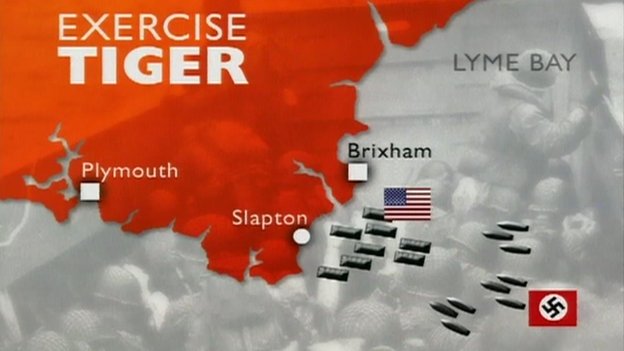
Image – BBC
A recent blog on this site described a walk at Slapton Sands in south Devon. It mentioned that training for the D Day Normandy landings took place at this location in April, 1944. This blog provides more detail about ‘Exercise Tiger’, the name given to the large-scale rehearsal that took place at Slapton, and involved 30,000 American troops (infantry, artillery, engineers, medical personnel and tank battalions) preparing with their assault ships, lorries and tanks for their landing as Force ‘U’ on Utah Beach in Normandy. The purpose of the exercise was to test a precise timetable for the Normandy landings, smooth out any unforeseen problems, and also test Anglo-US co-operation.
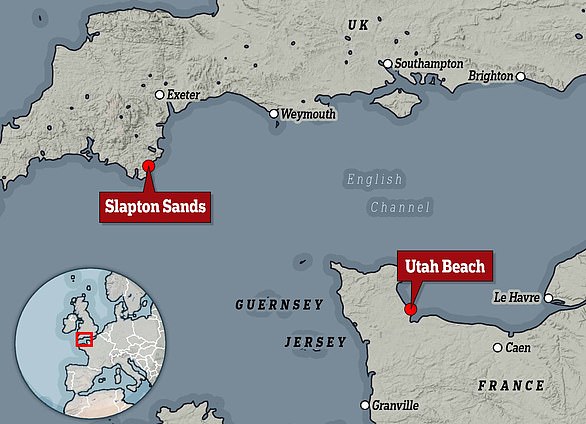
Image – Daily Mail
Slapton was chosen for this important exercise as it had been identified as being similar to the most westerly of the five invasion points in Normandy, code named as ‘Utah Beach’. In December, 1943, 3,000 citizens from seven local parishes were given just six weeks to pack up and leave their homes, taking with them everything they owned. They were not to return for at least ten months. A memorial obelisk by the beach car park at Slapton Sands was unveiled in 1954 by US Army authorities, and recognises the sacrifice made by these local people who gave up their homes and lands to provide a battle training area.

Memorial to evacuated residents. Image – Paul Berry

Monument inscription. Image – Paul Berry
Although it was believed that the training here had a huge part to play in the success of the D Day operations, it was not without its costs. 749 American servicemen lost their lives during the eight days of the rehearsal – many more than were lost during the actual invasion of Utah beach. General Eisenhower, the Supreme Allied Commander, had insisted that live ammunition should be used for realism, and friendly fire was sadly the cause of many deaths.

Training for the D Day landings. Image – Conseil Régional de Basse-Normandie / National Archives USA
The biggest disaster of all to blight Exercise Tiger, was the huge loss of servicemen following an attack on a training convoy by German ‘E boats’. These were fast running torpedo boats, called ’S boats’ (Schnellboote – ‘fast boats’) by the Germans.
On the evening of April 27th, 1944, a convoy of American ships (Convoy T4) sailed out of ports like Plymouth and Brixham, and took a long, winding route across Lyme Bay and back to simulate the length of the journey they would take during the ‘real thing’ when they approached Utah beach in Normandy. Protection was provided by the Royal Navy, who patrolled the area with four destroyers, 3 MTBs (Motor Torpedo Boats) and two MGBs (Motor Gun Boats). At the same time, another patrol of MTBs was keeping an eye on Cherbourg port in north west France, where German E boats were based.
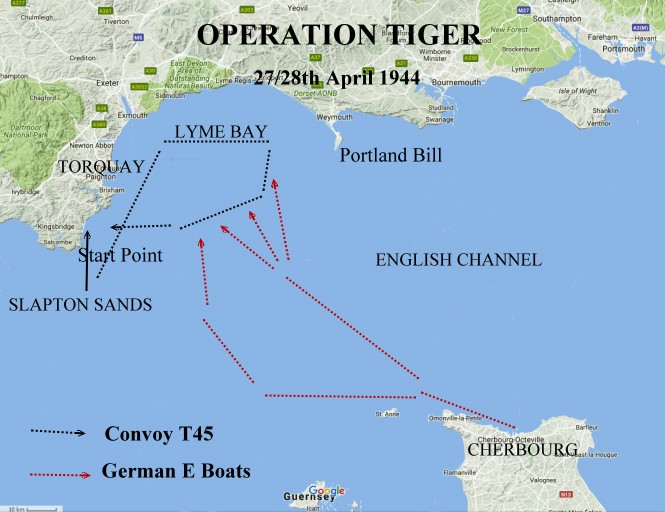
Route of the American convoy and line of attack by German E Boats. Image – Combined Operations
At the same time as the convey departed, German E boats left Cherbourg for a routine reconnaissance mission into Lyme Bay. Escort vessels for the convoy were provided by the Royal Navy in the form of a corvette (HMS Azelea) and a destroyer (HMS Scimitar). Just after 2.00 am on April 28th, four German E boats opened fire on the convoy of eight American LSTs (Landing Ship, Tank) – slow, flat bottomed assault ships containing several hundred troops, trucks, tanks and heavy equipment – the very same boats that would be used for the Utah beach landings. They were cruelly nicknamed ‘Large Slow Targets’ by the crewmen. The LSTs had little fire power and protection to offer, and three American vessels were torpedoed. Initially, the German torpedoes missed because of the flat-bottom hulls of the LSTs. LST 531 sank immediately, LST 507 was set ablaze and sank, while LST 289 managed to limp back to base at Dartmouth. 639 servicemen lost their lives. Many were trapped below decks and died from their wounds, while others perished in the sea due to hypothermia or drowning caused by poorly fitted lifebelts that dragged them and their heavy packs and helmets under the freezing cold water.
“Arthur Victor on LST 507 had heard Ensign Brown shout ‘Abandon ship’ and saw guys started over the sides in droves. Many landed on top of one another with a thud. Many soldiers, who for some reason were dressed for battle, pitched forward in the water with legs up and faces down. They were top heavy and struggled unsuccessfully to overcome it, even though I could see they were wearing lifebelts. It was unbelievable. Those who survived the jump swam towards the raft.” (from ‘Exercise Tiger’ by Richard Bass)
“Guys were dying all around us. Those without life preservers just let go, struggled a bit, then disappeared. Dead weight made it impossible to do much of anything to help them. One of the first to go was a corpsman who was only 19 years old, married and the father of a 4 month old son. He wasn’t wearing a lifebelt and had been holding on next to Rutherford. Suddenly and without warning he was struggling in the water, screaming for help. Star couldn’t reach him and Rutherford (who was still holding up the other corpsman) threw his leg to grab onto. He managed to get hold of the foot but slid off and sank beneath the surface. We waited for him to pop up, but he never did. In a twinkling he was gone. We were dumbfounded and frustrated and prayed for him. That’s all we could do.” (Arthur Victor – LST 507 – from ‘Exercise Tiger’ by Richard Bass)
Archie Jelly arrived at daybreak in MTB 704: “There were bodies floating about everywhere. We counted 70. Some had their eyes open, one had a split open in his head by a boat’s propellers. Our officers started to crook them in, to get their identity, then a message came through to leave them there, so that the Americans could pick them up. We put them back in the water again. It made our crew very down-hearted, we thought if that’s an exercise for D Day – God help us.” (from ‘Exercise Tiger’ by Richard Bass)
The catastrophic loss of life in Exercise Tiger became a closely protected secret, due to fears that Germany would gain information about the date of the anticipated Normandy landings. There was no leave given to survivors to recover from the trauma, and there was no time for mourning those who had died. The ‘lucky ones’ were reassigned to other LSTs and later took part in the D-Day invasion. Casualty figures from Exercise Tiger were hidden, and eventually absorbed into those from the later D Day landings.

Exercise Tiger landings. Image – Wessex Archaeology
Individual bodies retrieved at the time were buried temporarily at Brookwood Cemetery in Surrey, England. Records were kept on those whose bodies were lost at sea or who went down with the ships. After the war, those whose remains were not returned to the USA, were buried at Cambridge American Cemetery in England. Those whose bodies were not recovered have their names on the Wall of the Missing at Cambridge American Cemetery, or on the Wall at the Normandy American Cemetery in France.
At the village of Torcross, just south of Slapton, there is a tank memorial that honours the memory of the 749 American servicemen who perished in the area following Exercise Tiger, and an information board lists all of the soldiers who lost their lives in a roll of honour.

Tank recovered from Exercise Tiger. Image – Paul Berry
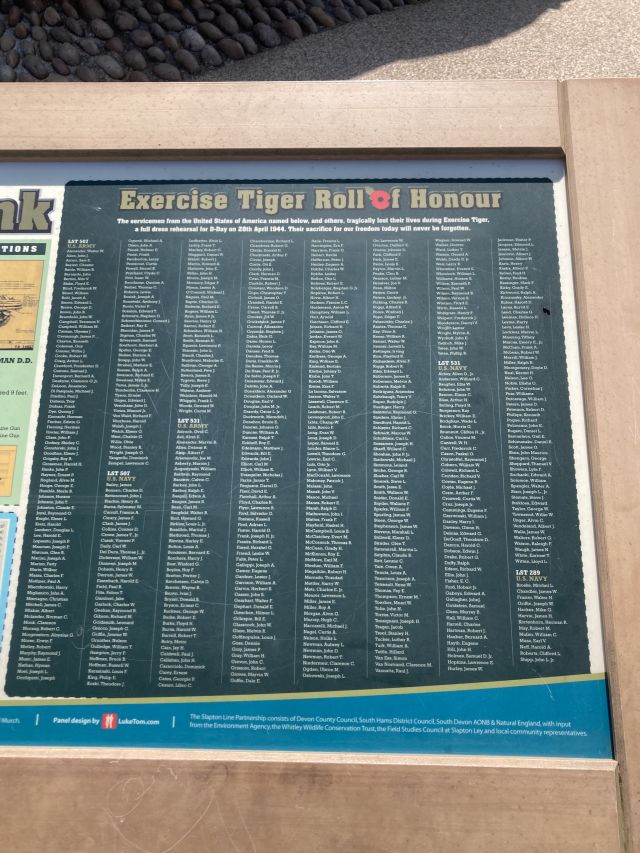
Lives lost during Exercise Tiger. Image – Paul Berry
The black tank was one of a number of American Sherman tanks modified during the exercise to become amphibious vehicles or ‘swimming tanks’. The armoured vehicles were fitted with a collapsible rubber canvas skirt held up by inflatable tubes and an iron hood to allow them to float. The tanks were propelled by tracks when on land and two propellers while in water, where they could reach speeds up to 5 knots (6 mph).
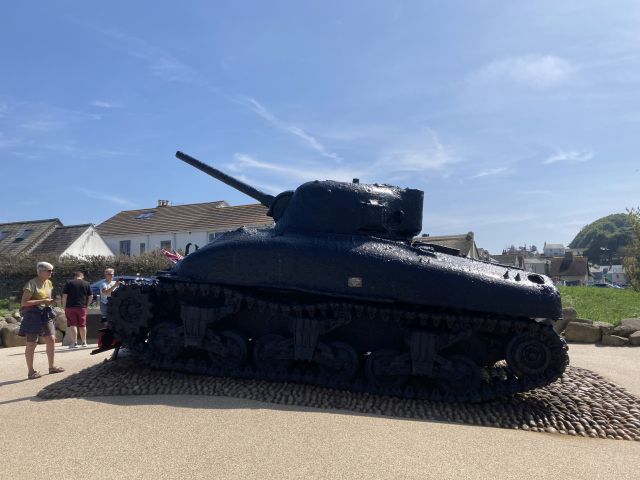
Image – Paul Berry
This particular tank, however, disembarked from a landing craft without its waterproof engine plate in place, and promptly sank in 65 feet of water around three quarters of a mile off shore. It was raised from the seabed in 1984 by Torcross hotelier Ken Small, with the assistance of local fishermen. Although it had been under water for some forty years, when it was hauled up the slipway its running tracks turned as freely as they did when it was first built. Ken Small fought through severe bureaucratic restrictions to bring the memorial to reality, and in the early days was often to be found next to tank talking to visitors and explaining what it was all about. His book ‘The Forgotten Dead’ tells of the recovery of the tank and the truth about Exercise Tiger, which was hidden from the public for many years.
An American military presence was not just found at Slapton during the War, there was a US naval battalion at Salcombe, and US vessels were also based at Dartmouth (including a number of minesweepers). In all, over 480 ships left Dartmouth as part of the D Day force, while over 60 sailed from Salcombe.
The D Day landing – the largest ever amphibious invasion consisting of over 7,000 ships and boats – was code named ‘Operation Overlord’, and eventually took place on June 5th and 6th, 1944. After the Soviets had inflicted defeats on Germany in the east, Hitler had pivoted to concentrate on a second front in the west in his attempt to defeat the Allies. He created an ‘Atlantic Wall’ of defence emplacements stretching from Norway to Spain – what he hoped would be an impregnable barrier for invading Allied troops.

Image – Amusing Planet
Five Normandy beaches were identified as invasion points – code named (from east to west) Sword, Juno, Gold, Omaha, and Utah. Omaha and Utah beaches were to be targeted by American troops, while the others were to receive landings from forces from the UK and Canada. Air landings from gliders were planned to precede the mass invasion in order to protect the flanks and seize key strategic bridges. After American paratroopers had arrived, the ships would follow, with Utah beach the first to be attacked (due to the prevailing tides). Aircraft were scheduled to bomb the beaches ahead of the troop landings, and battleships lined up offshore to fire their own broadsides. The invasion was not to be completed without its problems, friendly fire affected the landing troops, some of the tanks sunk in the sea before they reached land, and the invaders had to struggle against a heavily defended coastline with several concrete gun emplacements. The Americans experienced particular problems at Omaha beach and suffered a high casualty rate. Interestingly, prior to the invasion, General Eisenhower had prepared a public statement to issue in case of failure. Fortunately, due to the detailed planning and bravery of the troops, the D day landings proved to be an impressive success.
North Devon beaches were also used for preparation for the D Day landings, because of their similarity to Omaha beach in Normandy. The US Assault Training Centre was established here. The north Devon beaches were not large enough to accommodate the scale of exercise needed to prepare for Normandy, hence an alternative site was found at Slapton. Another blog on this site describes in detail the events that took place at Braunton, Saunton and Woolacombe in the build up to D Day.
